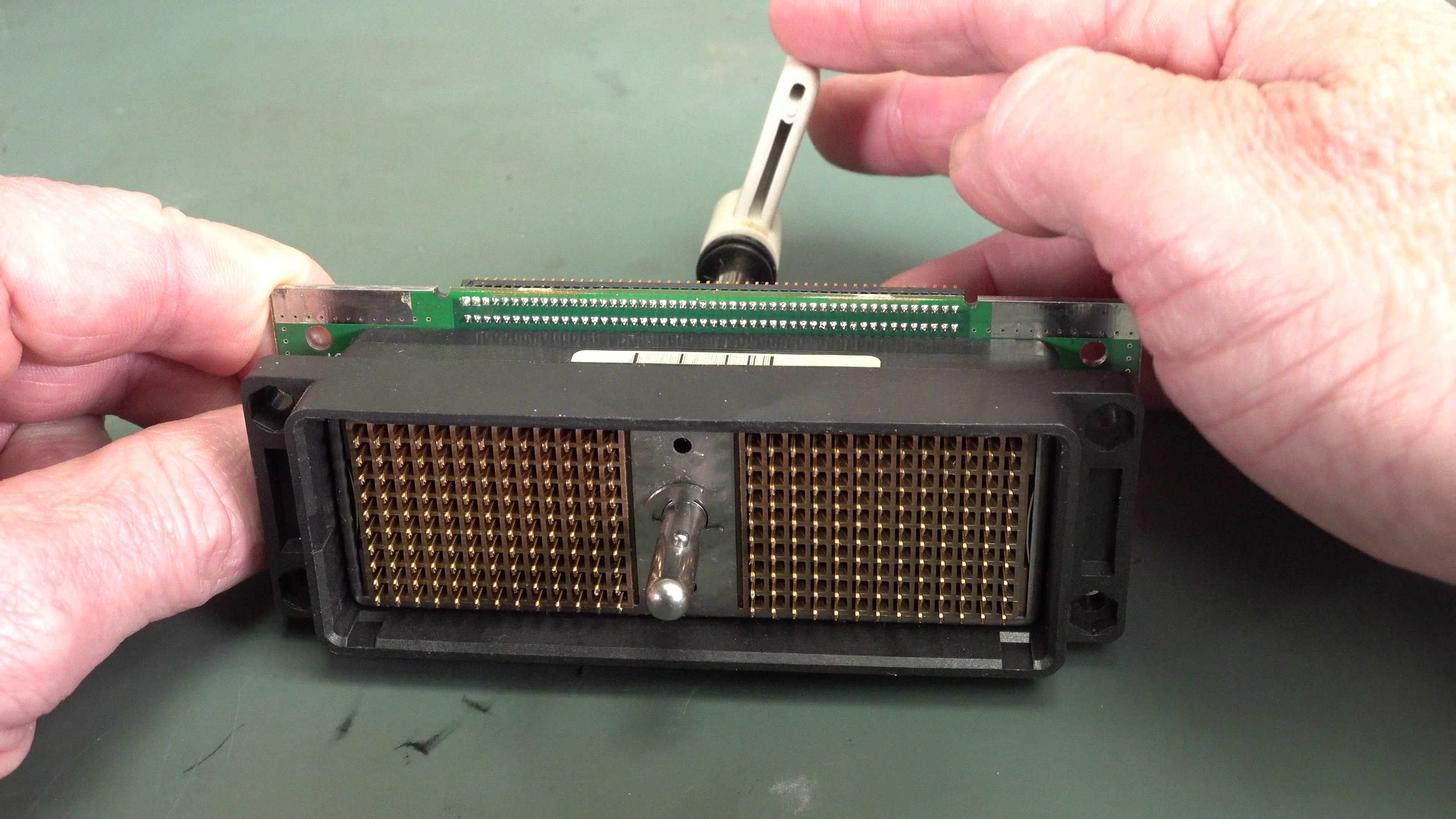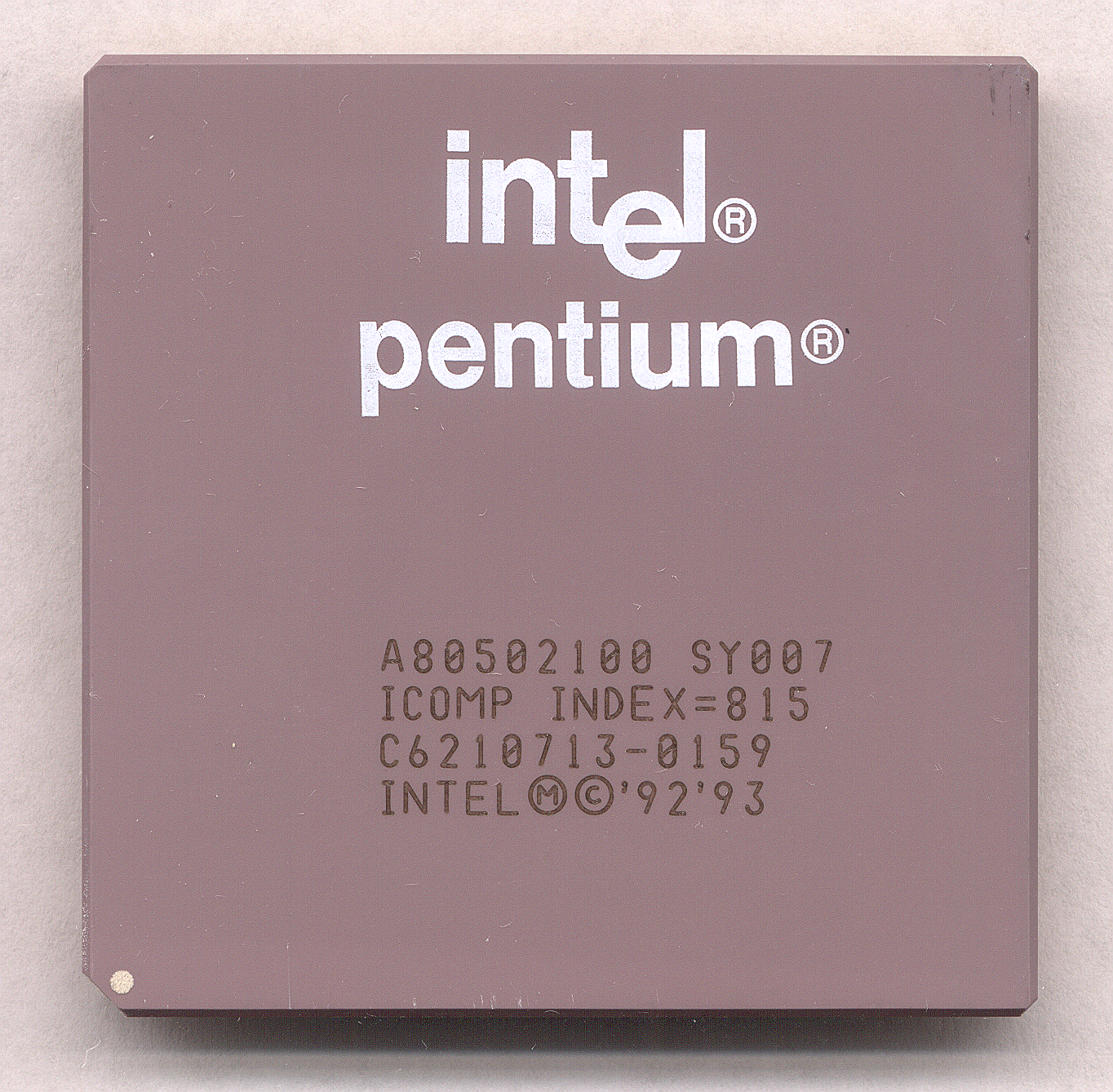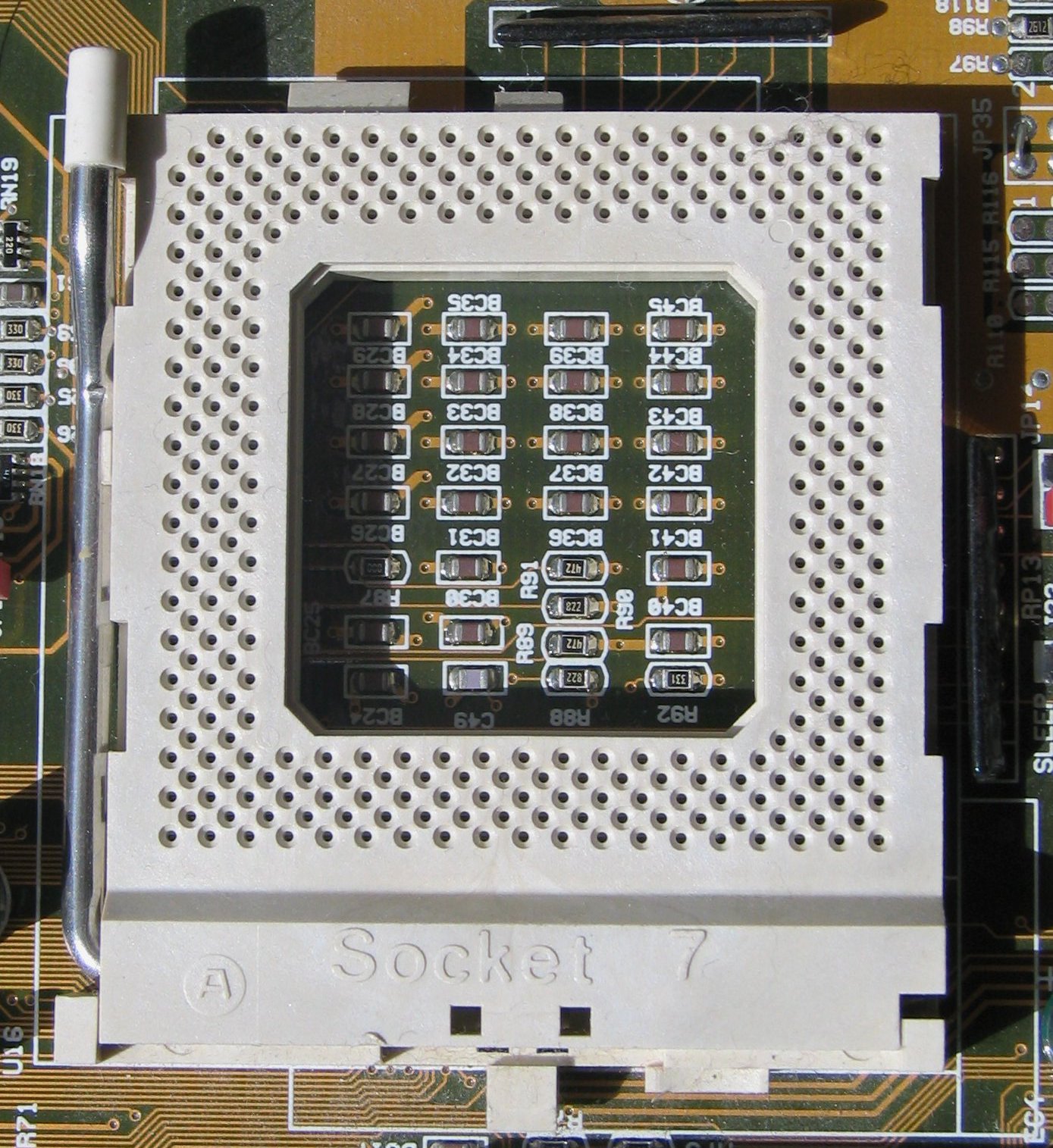|
Socket 5
Socket 5 was created for the second generation of Intel P5 Pentium processors operating at speeds from 75 to 133 MHz as well as certain Pentium OverDrive and Pentium MMX processors with core voltage 3.3 V. It superseded the earlier Socket 4. It was released in March 1994. Consisting of 320 pins, this was the first socket to use a staggered pin grid array, or SPGA, which allowed the chip's pins to be spaced closer together than earlier sockets. Socket 5 was replaced by Socket 7 in 1995. External linksDifferences between Socket 5 and Socket 7(archived) See also * List of Intel microprocessors * List of AMD microprocessors This article gives a list of AMD microprocessors, sorted by generation and release year. If applicable and openly known, the designation(s) of each processor's core (versions) is (are) listed in parentheses. For an overview over concrete product, ... References {{earlysock Socket 005 ... [...More Info...] [...Related Items...] OR: [Wikipedia] [Google] [Baidu] |
Zero Insertion Force
Zero insertion force (ZIF) is a type of IC socket or electrical connector that requires very little (but not literally zero) force for insertion. With a ZIF socket, before the IC is inserted, a lever or slider on the side of the socket is moved, pushing all the sprung contacts apart so that the IC can be inserted with very little force - generally the weight of the IC itself is sufficient and no external downward force is required. The lever is then moved back, allowing the contacts to close and grip the pins of the IC. ZIF sockets are much more expensive than standard IC sockets and also tend to take up a larger board area due to the space taken up by the lever mechanism. Typically, they are only used when there is a good reason to do so. Design A normal integrated circuit (IC) socket requires the IC to be pushed into sprung contacts which then grip by friction. For an IC with hundreds of pins, the total insertion force can be very large (hundreds of newtons), leading to ... [...More Info...] [...Related Items...] OR: [Wikipedia] [Google] [Baidu] |
Pin Grid Array
A pin grid array (PGA) is a type of integrated circuit packaging. In a PGA, the package is square or rectangular, and the pins are arranged in a regular array on the underside of the package. The pins are commonly spaced 2.54 mm (0.1") apart, and may or may not cover the entire underside of the package. PGAs are often mounted on printed circuit boards using the through hole method or inserted into a socket. PGAs allow for more pins per integrated circuit than older packages, such as dual in-line package (DIP). PGA variants Plastic Plastic pin grid array (PPGA) packaging was used by Intel for late-model Mendocino core Celeron processors based on Socket 370. Some pre-Socket 8 processors also used a similar form factor, although they were not officially referred to as PPGA. Flip chip A flip-chip pin grid array (FC-PGA or FCPGA) is a form of pin grid array in which the die faces downwards on the top of the substrate with the back of the die exposed. This ... [...More Info...] [...Related Items...] OR: [Wikipedia] [Google] [Baidu] |
Intel
Intel Corporation is an American multinational corporation and technology company headquartered in Santa Clara, California, Santa Clara, California. It is the world's largest semiconductor chip manufacturer by revenue, and is one of the developers of the x86 series of instruction sets, the instruction sets found in most personal computers (PCs). Delaware General Corporation Law, Incorporated in Delaware, Intel ranked No. 45 in the 2020 Fortune 500, ''Fortune'' 500 list of the largest United States corporations by total revenue for nearly a decade, from 2007 to 2016 fiscal years. Intel supplies microprocessors for List of computer system manufacturers, computer system manufacturers such as Acer Inc., Acer, Lenovo, HP Inc., HP, and Dell Technologies, Dell. Intel also manufactures motherboard chipsets, network interface controllers and integrated circuits, flash memory, Graphics processing unit, graphics chips, Embedded system, embedded processors and other devices related to com ... [...More Info...] [...Related Items...] OR: [Wikipedia] [Google] [Baidu] |
P5 (microarchitecture)
The Pentium (also referred to as P5, its microarchitecture, or i586) is a fifth generation, 32-bit x86 microprocessor that was introduced by Intel on March 22, 1993, as the very first CPU in the Pentium brand. It was instruction set compatible with the 80486 but was a new and very different microarchitecture design from previous iterations. The P5 Pentium was the first superscalar x86 microarchitecture and the world's first superscalar microprocessor to be in mass productionmeaning it generally executes at least 2 instructions per clock mainly because of a design-first dual integer pipeline design previously thought impossible to implement on a CISC microarchitecture. Additional features include a faster floating-point unit, wider data bus, separate code and data caches, and many other techniques and features to enhance performance and support security, encryption, and multiprocessing, for workstations and servers when compared to the next best previous industry standard p ... [...More Info...] [...Related Items...] OR: [Wikipedia] [Google] [Baidu] |
Pentium (brand)
Pentium is a brand used for a series of x86 architecture-compatible microprocessors produced by Intel. The original Pentium processor from which the brand took its name was first released on March 22, 1993. After that, the Pentium II and Pentium III were released. In their form , Pentium processors are considered entry-level products that Intel rates as "two stars", meaning that they are above the low-end Atom and Celeron series, but below the faster Intel Core lineup, and workstation/server Xeon series. , Pentium processors have little more than their name in common with earlier Pentiums, which were Intel's flagship processor for over a decade until the introduction of the Intel Core line in 2006. They are based on both the architecture used in Atom and that of Core processors. In the case of Atom architectures, Pentiums are the highest performance implementations of the architecture. Pentium processors with Core architectures prior to 2017 were distinguished from the fast ... [...More Info...] [...Related Items...] OR: [Wikipedia] [Google] [Baidu] |
AMD K5
The K5 is AMD's first x86 processor to be developed entirely in-house. Introduced in March 1996, its primary competition was Intel's Pentium microprocessor. The K5 was an ambitious design, closer to a Pentium Pro than a Pentium regarding technical solutions and internal architecture. However, the final product was closer to the Pentium regarding performance, although faster clock-for-clock compared to the Pentium. Technical details The K5 was based upon an internal highly parallel Am29000 RISC processor architecture with an x86 decoding front-end. The K5 offered good x86 compatibility and the in-house-developed test suite proved invaluable on later projects. All models had 4.3 million transistors, with five integer units that could process instructions out of order and one floating-point unit. The branch target buffer was four times the size of the Pentium's and register renaming helped overcome register dependencies. The chip's speculative execution of instructions reduced ... [...More Info...] [...Related Items...] OR: [Wikipedia] [Google] [Baidu] |
WinChip
The WinChip series was a low-power Socket 7-based x86 processor designed by Centaur Technology and marketed by its parent company IDT. Overview Design The design of the WinChip was quite different from other processors of the time. Instead of a large gate count and die area, IDT, using its experience from the RISC processor market, created a small and electrically efficient processor similar to the 80486, because of its single pipeline and in-order execution microarchitecture. It was of much simpler design than its Socket 7 competitors, such as AMD K5/ K6, which were superscalar and based on ''dynamic'' translation to buffered micro-operations with advanced instruction reordering ( out of order execution). Use WinChip was, in general, designed to perform well with popular applications that did few (if any) floating point calculations. This included operating systems of the time and the majority of software used in businesses. It was also designed to be a drop-in replacem ... [...More Info...] [...Related Items...] OR: [Wikipedia] [Google] [Baidu] |
Socket 4
Socket 4, presented in 1993, was the first CPU socket designed for the early P5 Pentium microprocessor A microprocessor is a computer processor where the data processing logic and control is included on a single integrated circuit, or a small number of integrated circuits. The microprocessor contains the arithmetic, logic, and control circu ...s. Socket 4 was the only 5-volt socket for the Pentium. Socket 4 does support a special Pentium OverDrive, which allows running at 120 MHz (for the 60 MHz Pentium) or 133 MHz (for the 66 MHz Pentium). Socket 4 was superseded by the 3.3-volt-powered Socket 5 in 1994. See also * List of Intel microprocessors References {{earlysock Socket 004 ... [...More Info...] [...Related Items...] OR: [Wikipedia] [Google] [Baidu] |
Socket 7
Socket 7 is a physical and electrical specification for an x86-style CPU socket on a personal computer motherboard. It was released in June 1995. The socket supersedes the earlier Socket 5, and accepts P5 Pentium microprocessors manufactured by Intel, as well as compatibles made by Cyrix/ IBM, AMD, IDT and others. Socket 7 was the only socket that supported a wide range of CPUs from different manufacturers and a wide range of speeds. Differences between Socket 5 and Socket 7 are that Socket 7 has an extra pin and is designed to provide dual split rail voltage, as opposed to Socket 5's single voltage. However, not all motherboard manufacturers supported the dual voltage on their boards initially. Socket 7 is backwards compatible; a Socket 5 CPU can be inserted and used on a Socket 7 motherboard. Processors that used Socket 7 are the AMD K5 and K6, the Cyrix 6x86 and 6x86MX, the IDT WinChip, the Intel P5 Pentium (2.5–3.5 V, 75–200 MHz), the Pentium MMX (166� ... [...More Info...] [...Related Items...] OR: [Wikipedia] [Google] [Baidu] |
Pentium OverDrive
The Pentium OverDrive was a microprocessor marketing brand name used by Intel, to cover a variety of consumer upgrade products sold in the mid-1990s. It was originally released for 486 motherboards, and later some Pentium sockets. Intel dropped the brand, as it failed to appeal to corporate buyers, and discouraged new system sales. 486 sockets The Pentium OverDrive is a heavily modified, 3.3 volt Pentium P54 core manufactured on 0.6 micrometer technology. It is fitted with a 486-compatible bus unit (though with an increased pin-count), an integrated heatsink and fan, and 32 kB of level 1 cache, double the 16 kB offered on regular P54C chips. As the data bus was effectively reduced to 32-bit width, per-clock performance was much lower than that of a 'regular' Pentium, though still substantially faster compared to a similarly clocked 486 owing to the Pentium's architectural improvements, such as the much improved FPU. It was also equipped with an integrated 3.3 volt power regulator ... [...More Info...] [...Related Items...] OR: [Wikipedia] [Google] [Baidu] |
Pentium MMX
The Pentium (also referred to as P5, its microarchitecture, or i586) is a fifth generation, 32-bit x86 microprocessor that was introduced by Intel on March 22, 1993, as the very first CPU in the Pentium brand. It was instruction set compatible with the 80486 but was a new and very different microarchitecture design from previous iterations. The P5 Pentium was the first superscalar x86 microarchitecture and the world's first superscalar microprocessor to be in mass productionmeaning it generally executes at least 2 instructions per clock mainly because of a design-first dual integer pipeline design previously thought impossible to implement on a CISC microarchitecture. Additional features include a faster floating-point unit, wider data bus, separate code and data caches, and many other techniques and features to enhance performance and support security, encryption, and multiprocessing, for workstations and servers when compared to the next best previous industry standard proc ... [...More Info...] [...Related Items...] OR: [Wikipedia] [Google] [Baidu] |


_CPU-pins_PNr°0295.jpg)




